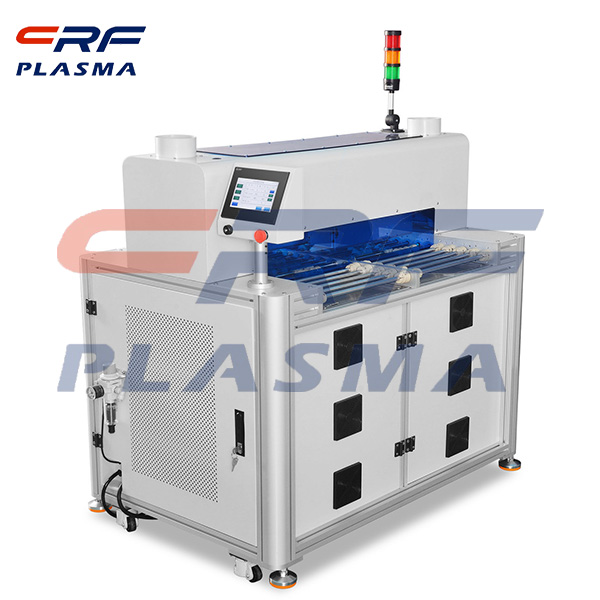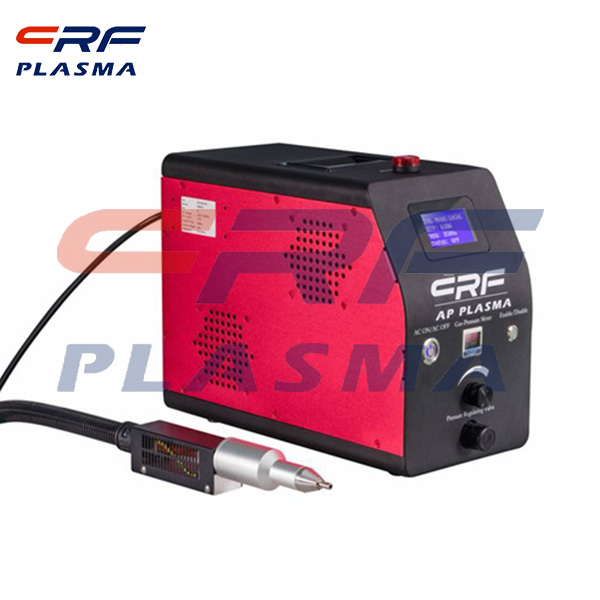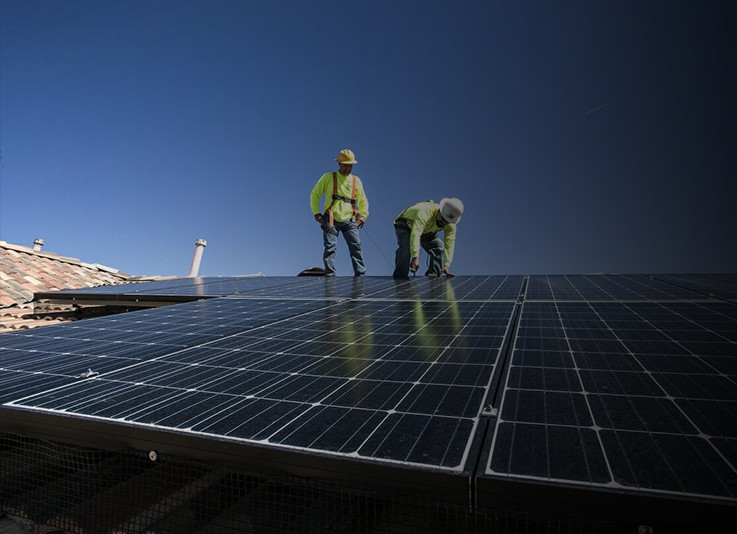
Welcome to Shenzhen Sing Fung Intelligent Manufacturing Co., Ltd.
E-mail:shaobo@sfi-crf.com
Plasma surface modification of polymer materials
- Categories:Company Dynamics
- Author:plasma cleaning machine-surface treatment equipment-CRF plasma machine-Sing Fung Intelligent Manufacturing
- Origin:
- Time of issue:2020-12-03
- Views:
(Summary description)In the modification of polymer materials, the application of plasma surface treatment is mainly as follows:Surface hydrophilic or hydrophobic:The hydrophilic groups such as COOH, -C=O, -NH2 and -OH will be added to the surface of ordinary polymer materials after being treated by gas plasmas such as NH3, O2, CO, Ar, N2 and H2. The longer the treatment time is, the lower the contact Angle of the droplets will be, and the fluoropolymer surface will increase its hydrophobicity after being treated by fluoropolymer such as CF4 and CH2F2 plasma. The results showed that the contact Angle between the untreated PET film and water was 73.1°, and it was treated with Ar plasma for 5min. After being placed for a day, the contact Angle with water decreased to 33.7°. The contact Angle increased slowly with the extension of time, indicating that the treatment effect declined with time. The contact Angle measured after 10 days was 41.3°. After 20 days of treatment with N2 plasma, the surface polarity of LDPE disappeared. After plasma treatment of oxygen on the surface of 3-hydroxybutyl-3-hydroxypentanoic acid copolymer film, it was also found that the contact Angle of oxygen recovered from 20° to 70° after 60 days. It is believed that the polar groups introduced by plasma surface treatment are attenuated due to the movement of the polymer chain and thus transferred to the polymer material body. PET membrane is immersed in organic solvent with strong interaction before treatment. The rearrangement of molecular chains caused by solvent reduces chain activity and can stabilize the treatment effect. The treatment effect decays not only with time but also with temperature. The surface of the polymer film was treated by O2 plasma and heat-treated at 80~140℃. The results showed that the surface tension and wettability of the film were increased after plasma treatment, and the plasma treatment effect was weakened after heat treatment. After heat treatment of PET, nylon and other surfaces, the surface energy and surface-COOH and -OH groups decreased significantly. The surface tension of polyimide and polyphenylene sulfide decreased obviously after heat treatment. This also indicates from one side that the difficulty degree of the polymer molecular chain itself in motion is also an important factor affecting the speed of reaction. Improve bonding ability: Plasma treatment can easily introduce polar groups or active points on the surface of polymer materials, form chemical bonds with the bonded materials and adhesives, and improve the bonding performance by increasing the van der Waals (intermolecular forces) between the bonded materials and adhesives. This process is not limited by the material quality and will not damage the overall mechanical properties of the material, which is far better than the common chemical process. Plasma treatment can obviously improve the adhesion between polymer films and improve the mechanical properties of composites. If the bonding property between the reinforced fiber and the base is not good, the stress cannot be transferred well, instead, the stress concentration source will be generated, leading to the deterioration of the mechanical properties of the composite. Ultrahigh molecular weight polyethylene (UHMWPE) fibres are plastically treated to enhance their binding strength with epoxy resins by more than four times. After treating polyethylene fiber with Ar, N2, CO2 and other gas plasma, the bonding between polyethylene fiber and PMMA(polymethyl methacrylate) was enhanced. Its toughness index and breaking strength, plasma treatment of high strength PE fiber can improve the fiber - epoxy resin composite bonding strength. Improve printing and dyeing ability: On the one hand, plasma surface treatment can increase the surface roughness of the treated material, destroy its amorphous region, make the surface structure of the treated material loose, and make the accessible area of dye/ink molecules increase due to the increase of the microgap; On the other hand, the introduction of polar groups on the surface can make the surface of the treated material easy to adsorb dye/ink molecules by intermolecular interaction force, hydrogen bond or chemical bond, thus improving the dyeing performance of the material. The adsorption of disperse dyes on PET fiber was enhanced by low temperature plasma treatment. After plasma treatment at low temperature, the linen fabric was washed with hot water. The dyeing properties of the fabric were good and the mechanical properties were not damaged. The dyeing properties of wool fabrics were improved by plasma treatment at low temperature. The use of toxic substances was reduced and the content of halogenated organic compounds was reduced before wool dyeing was treated by air plasma. Low temperature plasma method can improve dye fastness of polyester fiber. The surface modification of plasma polymers is mainly aimed at the surface modification
Plasma surface modification of polymer materials
(Summary description)In the modification of polymer materials, the application of plasma surface treatment is mainly as follows:Surface hydrophilic or hydrophobic:The hydrophilic groups such as COOH, -C=O, -NH2 and -OH will be added to the surface of ordinary polymer materials after being treated by gas plasmas such as NH3, O2, CO, Ar, N2 and H2. The longer the treatment time is, the lower the contact Angle of the droplets will be, and the fluoropolymer surface will increase its hydrophobicity after being treated by fluoropolymer such as CF4 and CH2F2 plasma. The results showed that the contact Angle between the untreated PET film and water was 73.1°, and it was treated with Ar plasma for 5min. After being placed for a day, the contact Angle with water decreased to 33.7°. The contact Angle increased slowly with the extension of time, indicating that the treatment effect declined with time. The contact Angle measured after 10 days was 41.3°. After 20 days of treatment with N2 plasma, the surface polarity of LDPE disappeared. After plasma treatment of oxygen on the surface of 3-hydroxybutyl-3-hydroxypentanoic acid copolymer film, it was also found that the contact Angle of oxygen recovered from 20° to 70° after 60 days. It is believed that the polar groups introduced by plasma surface treatment are attenuated due to the movement of the polymer chain and thus transferred to the polymer material body. PET membrane is immersed in organic solvent with strong interaction before treatment. The rearrangement of molecular chains caused by solvent reduces chain activity and can stabilize the treatment effect.
The treatment effect decays not only with time but also with temperature. The surface of the polymer film was treated by O2 plasma and heat-treated at 80~140℃. The results showed that the surface tension and wettability of the film were increased after plasma treatment, and the plasma treatment effect was weakened after heat treatment. After heat treatment of PET, nylon and other surfaces, the surface energy and surface-COOH and -OH groups decreased significantly. The surface tension of polyimide and polyphenylene sulfide decreased obviously after heat treatment. This also indicates from one side that the difficulty degree of the polymer molecular chain itself in motion is also an important factor affecting the speed of reaction.
Improve bonding ability:
Plasma treatment can easily introduce polar groups or active points on the surface of polymer materials, form chemical bonds with the bonded materials and adhesives, and improve the bonding performance by increasing the van der Waals (intermolecular forces) between the bonded materials and adhesives. This process is not limited by the material quality and will not damage the overall mechanical properties of the material, which is far better than the common chemical process. Plasma treatment can obviously improve the adhesion between polymer films and improve the mechanical properties of composites. If the bonding property between the reinforced fiber and the base is not good, the stress cannot be transferred well, instead, the stress concentration source will be generated, leading to the deterioration of the mechanical properties of the composite. Ultrahigh molecular weight polyethylene (UHMWPE) fibres are plastically treated to enhance their binding strength with epoxy resins by more than four times. After treating polyethylene fiber with Ar, N2, CO2 and other gas plasma, the bonding between polyethylene fiber and PMMA(polymethyl methacrylate) was enhanced. Its toughness index and breaking strength, plasma treatment of high strength PE fiber can improve the fiber - epoxy resin composite bonding strength.
Improve printing and dyeing ability:
On the one hand, plasma surface treatment can increase the surface roughness of the treated material, destroy its amorphous region, make the surface structure of the treated material loose, and make the accessible area of dye/ink molecules increase due to the increase of the microgap; On the other hand, the introduction of polar groups on the surface can make the surface of the treated material easy to adsorb dye/ink molecules by intermolecular interaction force, hydrogen bond or chemical bond, thus improving the dyeing performance of the material. The adsorption of disperse dyes on PET fiber was enhanced by low temperature plasma treatment. After plasma treatment at low temperature, the linen fabric was washed with hot water. The dyeing properties of the fabric were good and the mechanical properties were not damaged. The dyeing properties of wool fabrics were improved by plasma treatment at low temperature. The use of toxic substances was reduced and the content of halogenated organic compounds was reduced before wool dyeing was treated by air plasma. Low temperature plasma method can improve dye fastness of polyester fiber.
The surface modification of plasma polymers is mainly aimed at the surface modification
- Categories:Company Dynamics
- Author:plasma cleaning machine-surface treatment equipment-CRF plasma machine-Sing Fung Intelligent Manufacturing
- Origin:
- Time of issue:2020-12-03 09:11
- Views:
In the modification of polymer materials, the application of plasma surface treatment is mainly as follows:
Surface hydrophilic or hydrophobic:
The hydrophilic groups such as COOH, -C=O, -NH2 and -OH will be added to the surface of ordinary polymer materials after being treated by gas plasmas such as NH3, O2, CO, Ar, N2 and H2. The longer the treatment time is, the lower the contact Angle of the droplets will be, and the fluoropolymer surface will increase its hydrophobicity after being treated by fluoropolymer such as CF4 and CH2F2 plasma. The results showed that the contact Angle between the untreated PET film and water was 73.1°, and it was treated with Ar plasma for 5min. After being placed for a day, the contact Angle with water decreased to 33.7°. The contact Angle increased slowly with the extension of time, indicating that the treatment effect declined with time. The contact Angle measured after 10 days was 41.3°. After 20 days of treatment with N2 plasma, the surface polarity of LDPE disappeared. After plasma treatment of oxygen on the surface of 3-hydroxybutyl-3-hydroxypentanoic acid copolymer film, it was also found that the contact Angle of oxygen recovered from 20° to 70° after 60 days. It is believed that the polar groups introduced by plasma surface treatment are attenuated due to the movement of the polymer chain and thus transferred to the polymer material body. PET membrane is immersed in organic solvent with strong interaction before treatment. The rearrangement of molecular chains caused by solvent reduces chain activity and can stabilize the treatment effect.
The treatment effect decays not only with time but also with temperature. The surface of the polymer film was treated by O2 plasma and heat-treated at 80~140℃. The results showed that the surface tension and wettability of the film were increased after plasma treatment, and the plasma treatment effect was weakened after heat treatment. After heat treatment of PET, nylon and other surfaces, the surface energy and surface-COOH and -OH groups decreased significantly. The surface tension of polyimide and polyphenylene sulfide decreased obviously after heat treatment. This also indicates from one side that the difficulty degree of the polymer molecular chain itself in motion is also an important factor affecting the speed of reaction.
Improve bonding ability:
Plasma treatment can easily introduce polar groups or active points on the surface of polymer materials, form chemical bonds with the bonded materials and adhesives, and improve the bonding performance by increasing the van der Waals (intermolecular forces) between the bonded materials and adhesives. This process is not limited by the material quality and will not damage the overall mechanical properties of the material, which is far better than the common chemical process. Plasma treatment can obviously improve the adhesion between polymer films and improve the mechanical properties of composites. If the bonding property between the reinforced fiber and the base is not good, the stress cannot be transferred well, instead, the stress concentration source will be generated, leading to the deterioration of the mechanical properties of the composite. Ultrahigh molecular weight polyethylene (UHMWPE) fibres are plastically treated to enhance their binding strength with epoxy resins by more than four times. After treating polyethylene fiber with Ar, N2, CO2 and other gas plasma, the bonding between polyethylene fiber and PMMA(polymethyl methacrylate) was enhanced. Its toughness index and breaking strength, plasma treatment of high strength PE fiber can improve the fiber - epoxy resin composite bonding strength.
Improve printing and dyeing ability:
On the one hand, plasma surface treatment can increase the surface roughness of the treated material, destroy its amorphous region, make the surface structure of the treated material loose, and make the accessible area of dye/ink molecules increase due to the increase of the microgap; On the other hand, the introduction of polar groups on the surface can make the surface of the treated material easy to adsorb dye/ink molecules by intermolecular interaction force, hydrogen bond or chemical bond, thus improving the dyeing performance of the material. The adsorption of disperse dyes on PET fiber was enhanced by low temperature plasma treatment. After plasma treatment at low temperature, the linen fabric was washed with hot water. The dyeing properties of the fabric were good and the mechanical properties were not damaged. The dyeing properties of wool fabrics were improved by plasma treatment at low temperature. The use of toxic substances was reduced and the content of halogenated organic compounds was reduced before wool dyeing was treated by air plasma. Low temperature plasma method can improve dye fastness of polyester fiber.
The surface modification of plasma polymers is mainly aimed at the surface modification of polymer materials. The polymer has the molecular designability, through the plasma surface action, can introduce different groups on the polymer surface, such as hydrophilic, hydrophobic, wetting, bonding, etc., can also introduce bioactive molecules or biological enzymes, improve the biocompatibility of the polymer. The surface modification of polymer materials by using plasma technology can not only improve the application performance of polymer in specific environment, but also expand the application range of traditional polymer materials.

Scan the QR code to read on your phone

TEL:0755-3367 3020 / 0755-3367 3019

E-mail:sales-sfi@sfi-crf.com

ADD:Mabao Industrial Zone, Huangpu, Baoan District, Shenzhen

















